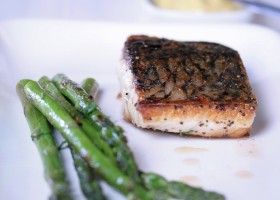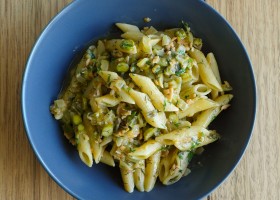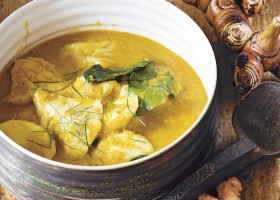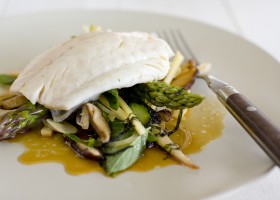Ingredients
- 4 x 170g hapuka fillets
- salt flakes and freshly-milled black pepper
- 2 Tbsp extra virgin olive oil
- 2 bunches asparagus, trimmed
- 1 bunch dill, picked
- ¼ cup mayonnaise
- 2 cloves garlic, minced
- zest and juice of 1 lemon
- 1 tsp seeded mustard
Hapuka

If you’ve not tried hapuka before, then you’re in for a surprise. It’s everything you may have expected in fish, and then a whole bunch more. It is more moist, more savoury, more lingering and layered than any fish you’ve previously tried.
Found mostly in the great southern trawl (a triangular area between Victoria, Tasmania and New Zealand) the fish go through several life stages that affect their fishing. While coastal dwellers as juveniles, mature hapuka head for the deep, mostly found between 200m and 800m below the surface, scrounging the seabed for food.
As such, many unethical fishery operators now drag-trawl the seabed for hapuka, destroying the grasses, corals and habitats in the process, ruining the marine environment for generations.
So if you want to try hapuka, and I think everyone should at least once, then insist on buying line-caught fish. You will pay a little more for it, but it’s a worthwhile investment. Not only will you get to sample one of the best fish in any part of the oceans, but you’ll also be taking a stance against reckless and destructive fisheries practices.
Method
Season the fish with salt and pepper, then rub with half the olive oil. Fry in a pan over a medium-high heat for 8 minutes, turning several times, until just firm.
Meanwhile, toss the asparagus with the remaining olive oil and fry in a pan over a high heat, until tender and lightly blackened. Toss with the dill and season with salt and pepper.
Mix the mayonnaise, garlic, zest, juice and mustard. Serve with fish with asparagus and the aioli.
Tips and Tricks
For maximum shelf life, store aparagus whole and unwashed in a sealed plastic bag in the vegetable drawer.
You know asparagus is going bad when the tips begin to turn dark green – It is still safe to eat at this point if you cut off the tips and cook immediately.
If you’re looking to keep lemons for longer than a week, place them in a thick plastic or zip-lock bag and store in your crisper. Lemons will last up to 4 weeks stored in this way.






